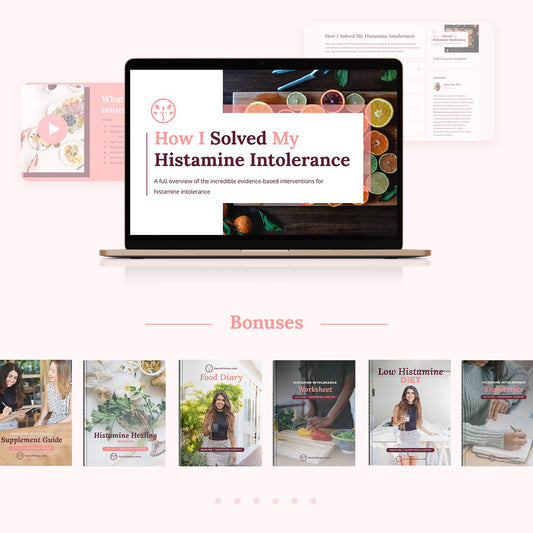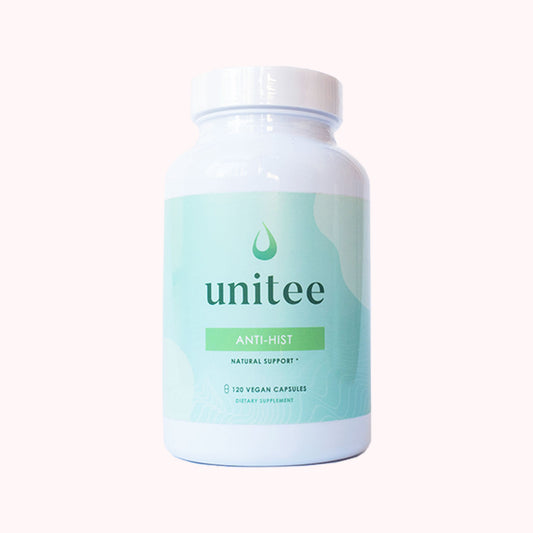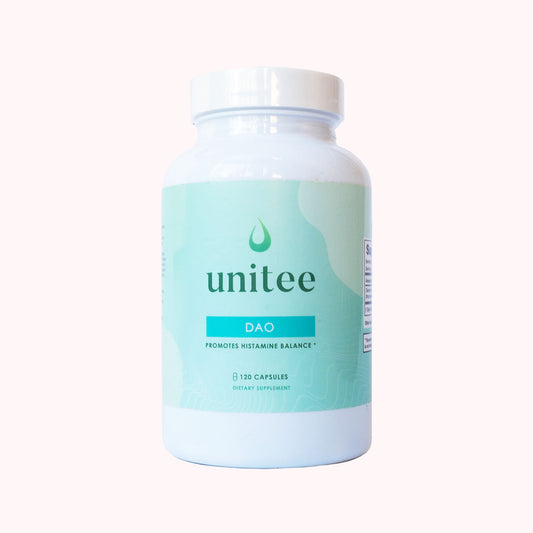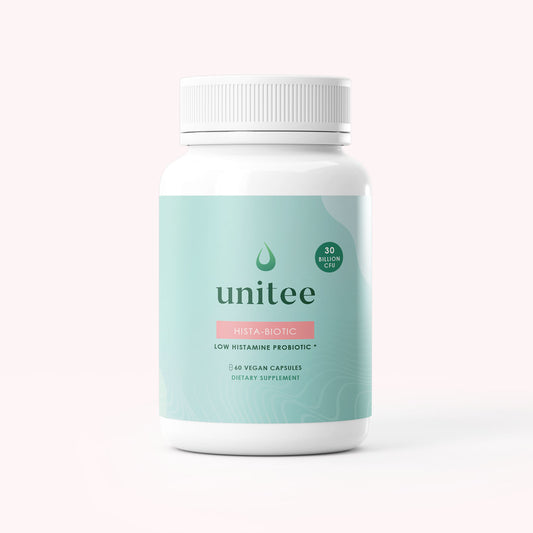Did you know, there are over 47 symptoms related to histamine intolerance! And while they can all cause severe dysfunction and bother, there’s one I can say is likely the worst of all: the itch.
That’s right. When histamine symptoms flare and your skin reacts, scratching just seems to make it worse. When you have the itch, you can’t find a comfortable position to rest in and little helps to soothe it, if anything does.
The intense itching can actually make you feel like you’re going crazy! So I’m here to help with a natural antihistamine for itching that really works.
My team and I have scoured our resources, put together our clinical knowledge, and finally have a solution to share with you. Wasting no more time, here’s my number one natural antihistamine for itchy skin.
Nettle: My Go-To Natural Antihistamine for Itchy Skin
Nettle is one of my favourite botanicals for relieving histamine-induced itchy skin, especially when the itching simply won’t cease.
Nettle is a leafy plant found worldwide. While you may know it well for its sting, there’s something else packed into this mighty plant to help you find relief, which is why it’s actually a key medicinal plant used for thousands of years both in ancient and modern times alike.
Now, not every species causes a sting, but those that do, have tiny needle-like projections located on the leaves, which inject histamine and other inflammatory compounds directly into the skin upon contact. The histamine causes welts, inflammation, swelling and itching, much like the histamine in your own body does.
I know what you’re thinking! How does nettle work to reduce histamine-induced itching if it causes histamine-induced itching?
Well, the leaves induce stinging as a protective mechanism but, when prepared properly, nettle can have the opposite effects. When you tap into those valuable inner components within the nettle, they provide you with the anti-histamine and anti-inflammatory properties we’re looking for, making it a great natural antihistamine for itching relief (1).
How To Use this Natural Antihistamine for Itchy Skin
With nettle being my number one recommended natural antihistamine for hives, I’d love to ensure you know all of the ways you can use it!
Naturally, the first is to use it orally. When using nettle by mouth, it enters your system and can target three very important processes involved in the histamine reactions. Nettle can:
1. Block hypersensitive histamine receptors. Essentially, the compounds in nettle can bind to histamine receptors, blocking the ability of histamine to bind to them. When histamine has nowhere to go and no job to do, it is taken up by other immune cells and rendered useless. By cutting histamine off from doing its job, nettle drastically decreases the effects and symptoms of histamine intolerance.
2. Stop mast cells from releasing histamine. When an allergen enters the body, an enzyme called tryptase binds to mast cells telling them they need to help. Tryptase allows mast cells to release their contents, which includes histamines and other chemical mediators of histamine reactions. Nettle can inhibit tryptase, which means it doesn’t activate mast cells, and less histamine is allowed to enter your system (2).
3. Reduce inflammation. Those red and itchy welts you get after having a histamine reaction? Well, those are a combination of the effects of histamine and how it triggers inflammation. So the third way nettle acts as a powerful antihistamine for hives is through blocking enzymes involved in the inflammatory process. Nettle has been shown to block some of the key enzymes contributing to inflammation, for example, the COX-1, COX-2 and prostaglandin synthase enzymes (3).
Another way you can use nettle is topically. That’s right! Applying nettle directly is a great natural antihistamine for itchy skin. Now, don’t take the fresh leaves and put them on your skin; remember, stinging nettle has that name for a reason! Instead, here are some ways you can use it topically.
1. Use nettle tea. Who knew making a pot of tea could be a natural antihistamine for itchy skin! You’d better believe it’s true. If you boil up 2-3 organic nettle leaf teabags in a pot of water, you can use the cooled tea as a wash or soak, applied directly to areas of your irritated or itchy skin. I find soaking a clean cotton cloth in the tea and covering the area of itchy skin is a wonderful and soothing way to find relief.
2. Infuse the leaves into an oil. If you do have access to fresh nettle, you can make a nettle infused oil at home. Note this method takes about 6-12 weeks for your final product, so feel free to use the methods above while you’re making your oil. To begin, collect your nettle leaves (I suggest using some thick garden gloves to prevent coming into contact with them!) and hang them to allow them to dry completely. It should take about 1-2 weeks, depending on how humid your environment is. You can also use a food dehydrator, which should dry your nettle in about 8-12 hours. Having your nettle leaves dried correctly is an essential step as you want to ensure you’re not allowing any mold to form. You’ll know they’re completely dried when the leaves crack and crumble when touched. Once the leaves are dried, crush them up and place them into a heat-safe jar. Cover the leaves entirely with a carrier oil such as olive oil or grapeseed oil and close the jar tightly. Place it in a warm spot and allow it to infuse for 6-12 weeks, swirling the mixture daily. Alternatively, if you just can’t wait to use your nettle oil, you can place the jar in a double boiler or warm water bath and heat it gently over the course of 2-4 hours. Most references, however, suggest the longer infusion method is best to achieve maximum extraction of nettle compounds in your oil, so do what makes the most sense to you! Once the oil is ready to go, strain the sediment using a fine cheesecloth and place in a clean jar. You can dab the oil directly onto areas of irritation on your skin as needed to help reduce the itch.
Now you know how to use nettle, I wanted to give you six other options you could use to find relief from histamine-induced itchy skin.
Need Natural Antihistamine for Itching? Here Are Six More!
While I’m a strong believer in the properties of nettle as an antihistamine for itchy skin, it’s far from the only plant ally available to get the job done. Here are six natural options that provide additional strategies to calm the itch and reduce histamine’s effects when it’s driving you to distraction.
1. Quercetin
Quercetin is not technically a botanical herb, but it’s a powerful flavonoid found in many medicinal plants that can serve as one of the most effective mast cell stabilizers in nature.
Quercetin has many ways in which it works as a potent natural antihistamine for itchy-skin relief. It can stabilize mast cells and prevent them from spilling histamine into your tissues. It has the ability to inhibit the release of inflammatory chemicals. It acts as an antioxidant, reducing oxidative stress that worsens inflammation and itching (4).
In fact, it is such a powerful natural antihistamine for itching, it has been compared to conventional medications, coming out on top due to its effects without the side effects often seen with antihistamine medication.
For this reason, we combine quercetin, nettle and other antihistamine botanicals into our powerful and all-natural antihistamine supplement.
2. Chamomile
Chamomile is not just a sleepy bedtime tea, it’s a gentle yet powerful antihistamine and anti-inflammatory herb. It has a long tradition in European herbal medicine, and works well for both acute skin flare-ups and chronic itching associated with histamine intolerance or even eczema.
Chamomile contains a similar compound to quercetin, which means it too can assist with mast cell stabilization and histamine inhibition. It also provides soothing mucilage and essential oils that calm irritated skin and reduce redness (5).
Just like nettle, chamomile can be used as a tea, cooled and used as a topical wash. To soothe the skin directly, brew a strong infusion of dried chamomile flowers and apply with a compress or pour into a lukewarm bath.
One note of caution for chamomile is for those of you with pollen allergies. It’s considered part of the Asteracea or daisy family, which has crossreactivity with ragweed and other pollen.
3. Baical skullcap
If you’re dealing with a more body-wide allergic pattern, skullcap (aka Chinese skullcap) offers broad-spectrum antihistamine and anti-inflammatory support. Rich in flavones like baicalin and baicalein, this herb helps to inhibit histamine release from mast cells, reduce various markers of allergic response, and suppress inflammatory pathways that worsen itching and skin irritation (6).
Traditional Chinese Medicine healers have used skullcap for thousands of years to treat conditions like hives, eczema, and even asthma. Modern research supports these applications, confirming it has a strong safety profile and proven efficacy in calming allergic responses.
4. Reishi mushroom
OK, ok, so if you know anything about medicinal mushrooms, reishi isn’t a botanical in the truest sense. It does, however, deserve a spot on this list for its exceptional natural antihistamine for itching effects.
Known as the “Mushroom of Immortality,” it works in two main ways. Firstly, it suppresses the production of specific immune compounds associated with allergic responses through modulation of the way certain immune cells behave. Secondly, it inhibits mast cell degranulation, reducing the release of histamine and other inflammatory mediators, which makes it a perfect addition to your anti-itch botanical medicines (7).
5. Licorice
The root of the licorice plant offers three strong actions against histamine-induced itchy, irritated skin. It helps the body conserve cortisol, which in turn modulates inflammation and histamine release. It’s also a mast cell stabilizer and offers soothing properties for both an inflamed gut or inhibited skin barrier; both of which can impact flares of histamine intolerance symptoms (8).
Note: long-term internal use of licorice should be supervised by a qualified healthcare practitioner, as it can reduce potassium levels in the body and subsequently raise blood pressure in sensitive individuals.
6. Tulsi
Tulsi, also known as holy basil, is a sacred herb, worshiped by many using Ayurvedic medicine—and it can prove a powerful tool in your toolkit when histamine reactions feel like they’re taking over your body. Its main actions as an adaptogenic or stress-modulating herb help stabilize the immune system, reduce mast cell degranulation, and calm your nervous system, all of which are critical when the itch just won’t quit (9).
Of note is tulsi’s effect on stress resilience. As you know, stress plays a surprisingly important role in histamine flares. Chronic stress enhances histamine production and lowers your threshold for allergic-type responses, including itching. So keeping stress in check, using an herb like tulsi, gives you even more power to control your symptoms.
Putting It All Together: Your Antihistamine Toolkit To Soothe Your Itchy Skin
So, what does this all mean for you? If histamine-related itching is making your life miserable, the answer might be hiding in the power of nature, and not in your medicine cabinet.
Here’s a recap of seven antihistamine herbs, specifically for itchy skin:
1. Nettle: blocks histamine receptors, prevents mast cell activation, and reduces inflammation. You can find it in our all-natural antihistamine combination supplement.
2. Quercetin: stabilizes mast cells and suppresses allergic reactions.
3. Chamomile: a soothing, calming, histamine-blocking remedy for irritation.
4. Baical Skullcap: possesses strong anti-allergic activity for skin and respiratory systems.
5. Reishi: an immune-modulating mushroom that reduces allergic response and skin inflammation.
6. Licorice root: a powerful anti-inflammatory that mimics cortisol and calms itchy skin.
7. Tulsi: an adaptogenic and antihistamine herb that balances immune and stress responses.
You don’t have to use all seven at once! Start by identifying where you most need support and what suits your individual needs best. Now you have the options to add internal relief, topical calm, or immune regulation herbs to your routine, choose 1–2 of these to start off with and keep track of how your body responds. You’ll quickly know which ones work best for you out of the bunch.
As always, if you’re taking medication, are pregnant, or are dealing with other chronic medical conditions in addition to histamine intolerance, be sure to confirm with your healthcare provider which of these options are safest for you to use.
With the right natural antihistamine remedies on hand, you can reduce the impact of histamine overload and are one step closer to calm, soothed, and comfortable skin.
References:
1. Randhawa M, et al. Urtica dioica L. (Stinging Nettle): A Review of Its Phytochemistry, Pharmacology, and Clinical Relevance. Iran J Basic Med Sci. 2015
2. Roschek B Jr, et al. Nettle extract (Urtica dioica) affects key receptors and enzymes associated with allergic rhinitis. Phytother Res. 2009.
3. Oguz S, Kanter M, Erboga M, et al. Protective effect of Urtica dioica on liver damage induced by biliary obstruction in rats. Toxicol Ind Health. Oct 2013;29(9):838-845.
4. Mlcek J, Jurikova T, Skrovankova S, Sochor J. Quercetin and Its Anti-Allergic Immune Response. Molecules. 2016;21(5):623.
5. Srivastava JK, Shankar E, Gupta S. Chamomile: A herbal medicine of the past with bright future. Mol Med Rep. 2010;3(6):895-901.
6. Jung HS, Kim MH, Gwak NG, et al. Antiallergic effects of Scutellaria baicalensis on inflammation in vivo and in vitro. J Ethnopharmacol. 2012;141(1):345-349.
7. Andoh T, Zhang Q, Yamamoto T, et al. Inhibitory effects of the methanol extract of Ganoderma lucidum on mosquito allergy-induced itch-associated responses in mice. J Pharmacol Sci. 2010;114(3):292-297.
8. Leite C., et al. The Anti-Inflammatory Properties of Licorice (Glycyrrhiza glabra)-Derived Compounds in Intestinal Disorders. Int J Mol Sci. 2022;23(8):4121.
9. Pradhan, D., et al. A comprehensive review on phytochemistry, molecular pharmacology, clinical and translational outfit of Ocimum sanctum L. South African Journal of Botany. 2022. 150L342-360.

Anita Tee
My name is Anita Tee. I'm a nutritional scientist who specializes in histamine intolerance. I hold a Master of Science in Personalized Nutrition and a Bachelor of Science in Human Biology and Psychology.
For the past ten years, I have used my experience in nutritional and medical health sciences to create a scientifically backed, natural approach to healthcare that relies 100% on evidence-based research.
As I previously suffered from - and overcame - histamine intolerance, my focus is to increase recognition and expand the available resources and protocols available for resolving this particular disorder. To date, I have helped over 4,000 individuals fully resolve or better manage their histamine intolerance symptoms.







